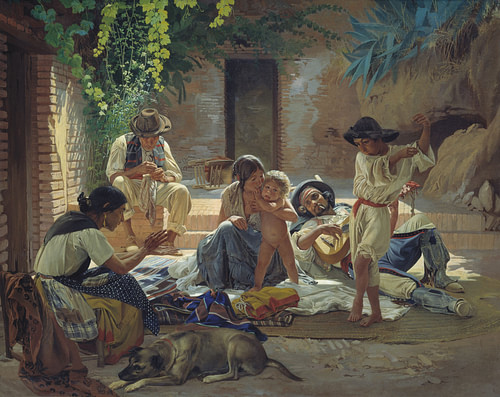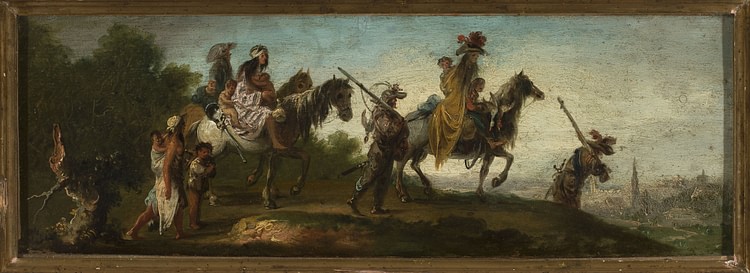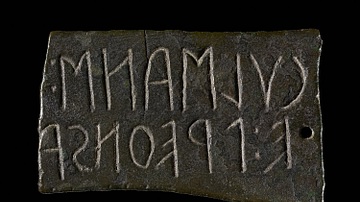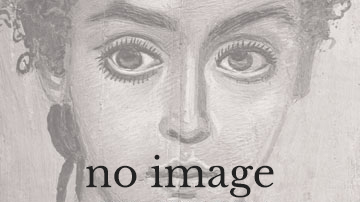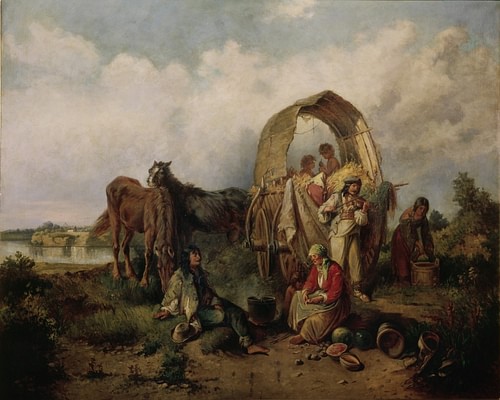
Romani is an Indo-European language, belonging to the Indic subbranch which includes Sanskrit and Hindi. Because of the Romani diaspora throughout Europe and West Asia, it developed in close contact with European and Iranian languages. It was through the study of the Romani Language that scholars first realized that its speakers had an origin in the Indian subcontinent.
In the 21st century, there are an estimated 3.5 million speakers of Romani around the world. However, it is no longer spoken by all or even most Romani communities and is a minority language in Europe. In the Romani diaspora, many people speak mixed Para-Romani languages or have adopted the majority language of their home country.
Origins of Proto-Romani
Romani language did not utilize a system of writing, and its origins have to be reconstructed by linguists. It is believed that speakers of Indo-Aryan, a branch of Indo-European languages, migrated into the Indian subcontinent in the 2nd millennium BCE. The oldest written examples of an Indo-Aryan or 'Indic' language are the Vedas, sacred texts which lend their name to the language Vedic Sanskrit. Old Indo-Aryan languages like Vedic Sanskrit and Classical Sanskrit developed into Middle Indo-Aryan languages known as Prakrits. Proto-Romani began to diverge from other Indic languages after this development, gradually evolving into its own language. This linguistic split must have occurred before the 1st millennium BCE because Romani does not contain developments common to other Indic languages after that period.
There is no scholarly consensus on where Proto-Romani speakers originated. One prominent theory posits that Proto-Romani may have developed in Central India before its speakers moved into northwest India. Another theory, which had widespread support in the 19th century, held that the language developed in northwest India sometime after Prakrit developed from Sanskrit.
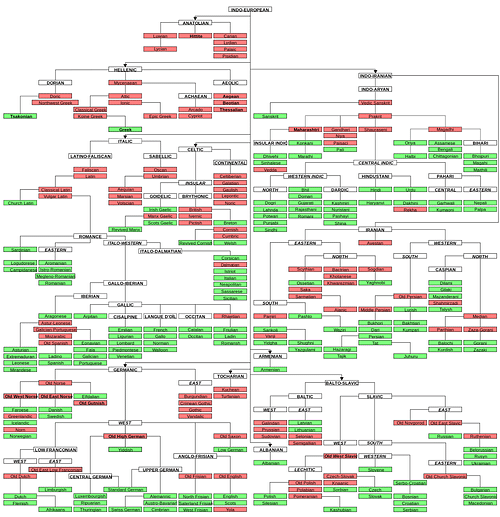
Whatever the origin of Proto-Romani, its speakers moved out of the Indian subcontinent and into West Asia by the 1st millennium CE. Most Proto-Romani speakers would have been bilingual or multilingual, learning the majority language in their home country as well as significant minority languages. As a result, Early Romani absorbed numerous features as its speakers migrated and came into contact with other languages.
Development
[T]he striking homogeneity of the Romani language, including a universal set of loanwords from Iranian languages, Armenian and Greek, and other pervasive influences from Greek shows indisputably that the ancestors of the Roma must have formed one community. (Bakker, 293-294)
Linguist Andrea Scala identified four main 'layers' of the Romani vocabulary. The foundational layer of the language is Indo-Aryan. Indo-Aryan words present in modern Romani are primarily those that describe core concepts like the environment, agriculture, food, kinship, emotions, and time. Words related to these topics are less likely to change over time or be replaced by loanwords. Most consonant sounds in Romani are inherited from Indo-Aryan, but the phonology of the language shifted considerably over time.
The second layer, Iranian vocabulary, was introduced sometime in the 1st millennium CE when Proto-Romani speakers moved through Central Asia and into Persia. Farsi and Kurdish grammar and vocabulary influenced Romani during this time. Despite Romani people having resided in the Middle East for a long period, Romani contains surprisingly few borrowings from medieval Arabic. Some scholars have suggested that this is evidence that the Romani had left Persia before the Muslim conquest of Persia in the 7th century. This absence could also be a consequence of Arabic's use as an elite language while the Romani in Persia would have continued to speak the more common languages.
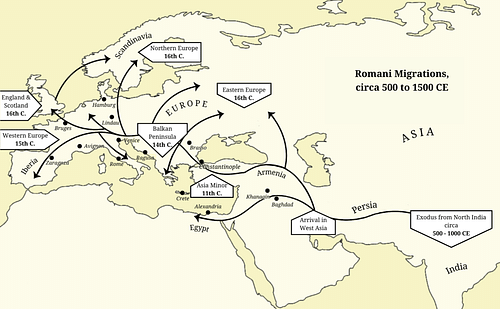
Proto-Romani speakers moved into Armenia sometime before the 11th century CE, acquiring words related to topics like religion, crops, and pack animals. Proto-Romani eventually developed into Early Romani, which is characterized by a large number of Greek lexical borrowings. Early and modern Romani contain a large number of Greek loanwords related to metals and metalworking, a consequence of the strong association between Romani people and blacksmiths in the Byzantine Empire and early medieval Balkans.
Greek is the final layer found in all dialects of modern Romani. This commonality means that the Romani migration must have brought all of them through Armenia and the Byzantine Empire before European Romani diverged into separate groups. As the Romani diaspora spread out, different dialects continued to adopt features of other languages most notably Romanian and Slavic.
Dialects
The absence of a standardized written form contributed to a great degree of variation between Romani dialects, some of which are not mutually intelligible. These dialects are often broadly grouped according to the geographic area in which they developed and the languages which influenced them. The complex history of Romani migration, which has seen numerous waves of population movement, has brought unrelated dialects into close contact with each other and created distance between once-close dialects. Linguist Yaron Matras observed that variation in Romani dialects often corresponds to geographic and ethnic differences, but that linguistic shifts also occurred along urban-rural, generational, and gender divides.
The first attempt to classify each Romani dialect was made by Slovene philologist Franz Miklosich (1813-1891), who traced the migration of the Romani people by studying how words were borrowed from different languages. Miklosich divided Romani into 13 dialects spoken among groups that settled in different parts of Europe. Modern linguists generally separate Romani dialects into 12 branches:
- South Balkan
- North Balkan
- Apennine
- South Central
- North Central
- Transylvanian
- Vlax
- Ukrainian
- Iberian
- Slovene
- Northeastern
- Northwestern
Some of these branches are now extinct and are known only through historical sources and borrowings in other languages. The most widely spoken branch of Romani is Vlax Romani, which is believed to have developed in Romania. The dialect is named after Wallachia, a region of Romania where a significant number of enslaved Romani, the Vlax Roma, had lived since the 13th century. The migration of the Vlax Roma out of Romania after their emancipation in the 19th century brought the dialect to other parts of Europe, Asia, Australia, and the Americas.
Para-Romani Languages & Cants
A number of Para-Romani languages formed in bilingual communities through the mixing of Romani vocabulary with the grammar of locally spoken European languages. The structure of these diaspora languages and the conditions they developed under are similar to Jewish mixed languages such as Yiddish and Ladino. Para-Romani languages belong to a variety of groups including the Germanic, Slavic, and Romance languages.
Anti-Romani sentiments and policies in many countries led to the loss of Romani language in some communities in favour of the majority language. Some Para-Romani languages survived after the local Romani dialect they were based on went extinct. For example, Caló developed in the Iberian Peninsula and is based on a Spanish grammatical system, with borrowings from the now-extinct Iberian dialect of Romani.
Due to the wide geographical spread of the Romani people, loanwords from Romani and Para-Romani languages have entered several European languages, often as slang or informal terms. The English word pal, meaning a friend, comes from the Romani word phral ("brother"), which in turn derives from the Sanskrit bhrā́tṛ. Romani loanwords are also found in many cants or jargons, like Polari and Rotwelsch, which were used in the past by groups such as fairground workers, travellers, actors, sailors, ethnic minorities, and LGBT people. These cants developed through contact between people who, because of their ethnicity, occupation, or orientation, were marginalized by society.
Historical Sources
Reconstructions of Proto-Romani and its development into the extant Romani dialects are complicated by the scarcity of early written Romani. The oldest known example of written Romani was transliterated into Latin by Johannes ex Grafing, a Benedictine monk living in Vienna c. 1505-1510.
The Fyrst Boke of the Introduction of Knowledge, written by English writer Andrew Boorde (1490-1549) in 1547, contains one of the most well-studied examples of early written Romani. Boorde transliterated phrases of what he called "Egypt speche", which he likely heard at alehouses and inns during his travels in Sussex. He was unaware of the language's origins and included it in a chapter on the country of Egypt.
As Romani people became better known in Europe during the early modern period, more transliterations of the Romani language began to appear in literature. The Flemish humanist Bonaventura Vulcanius (1538-1614) was the first to publish a Romani lexicon, which he also translated into Latin. During the early 17th century, Romani was translated into other languages like Spanish and Ottoman Turkish.
History of Romani Linguistics
Many medieval and early modern European writers mistakenly assumed that Romani was an invented thieves' cant, used to hide criminal activities from outsiders. This assumption was based on negative stereotypes about Romani as a class of criminals rather than a community with a distinct culture. As early as Vulcanius, some scholars began to characterize Romani as a proper language and took an interest in its development.
In the 18th century, law enforcement in many Western European countries began studying languages used by minorities and travelling communities out of a desire to suppress them. This led to a wider awareness that Romani was a very different phenomenon than thieves' cants. At this point, scholars began making comparative studies of Romani with other world languages, seeking similarities that would reveal its origin.
In the middle of the second half of the eighteenth century, interest in Romani entered a new phase that paved the way for a truly scientific approach, based on a strictly linguistic study and applying a solid methodology. The key is the establishment of a connection between Romani and the Indo-Aryan languages, which placed Romani within this group as a daughter of Proto-Indo-European, like Greek, Latin, Germanic, Balto-Slavic and other languages and linguistic groups of Eurasia. (Adiego, 70-71)
It was quickly realized that Romani bore no similarity to Coptic or any other language associated with Egypt, and linguists shifted their search eastwards. The discovery of Romani's link to India is attributed to a circle of Hungarian and Sri Lankan university students in the Netherlands in the 1750s or 1760s. A popular story claims that the Hungarian Calvinist theologian István Vályi noticed similarities between Sanskrit spoken by three students from Malabar at Leiden University and the language spoken by Romani in his home country. According to Romani scholar Ian Hancock, this story may contain some truth as Vályi attended the nearby University of Utrecht in 1753 and could have visited Leiden during the years in which those Malabar students were in attendance.
Vályi's comparison was the first evidence that the Romani people had originated in India, rather than Egypt as had previously been assumed. Based on this discovery, Johann Rudiger announced his findings that Romani was an Indic language in 1777. Other linguists like Jacob Bryant might have independently reached the same conclusion.
In 1844, linguist August Pott (1802-1887) published the first detailed analysis of the relationship between Romani and Indic languages, and he is often considered the founder of Romani linguistics. Throughout the end of the century, numerous scholars attempted to identify the modern language most similar to Romani, and in so doing trace the origins of its speakers. Indian languages such as Urdu, Hindustani, Sindhi, and Gujarati were all offered as potential candidates.
Legacy
The study of the Romani language created the framework for the study of Romani history and culture and inspired academic interest in other areas of Romani history. The first works on the Romani migration were published shortly after the discovery of Romani's linguistic origins and created a surge of interest in documenting Romani folklore and customs.
The language also became a unifying factor between Romani communities in different parts of the world, which had previously had little interaction. Since the 19th century, there have been efforts to establish a standardized orthography for writing Romani using the Latin alphabet. Efforts to create a standard Romani dialect for international usage began in the 20th century.

